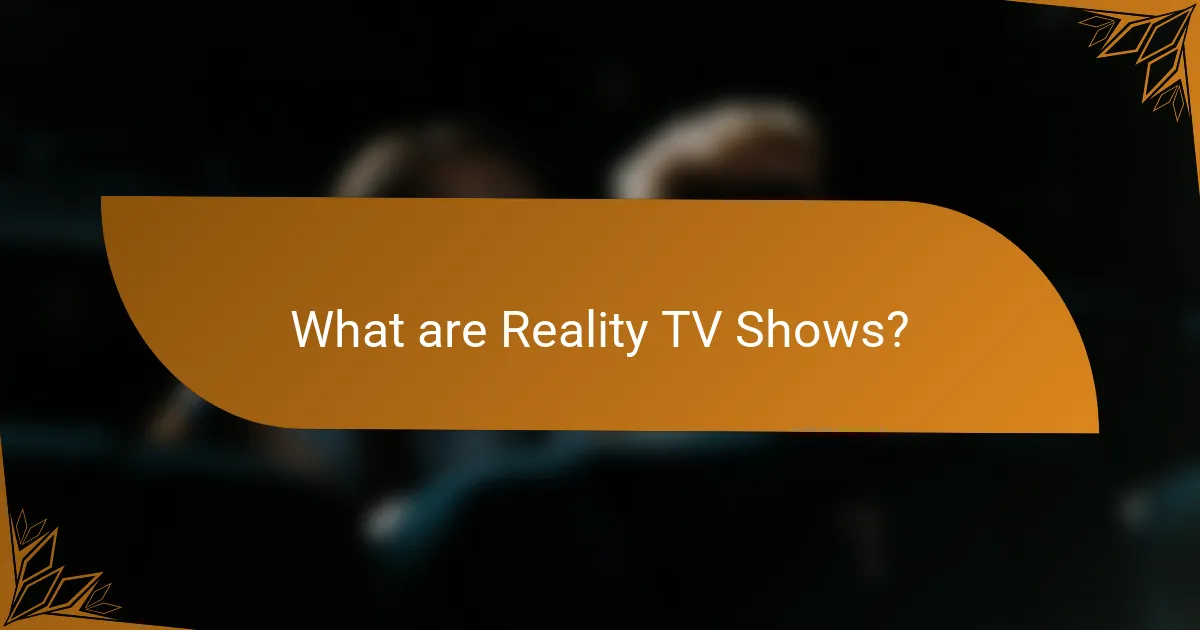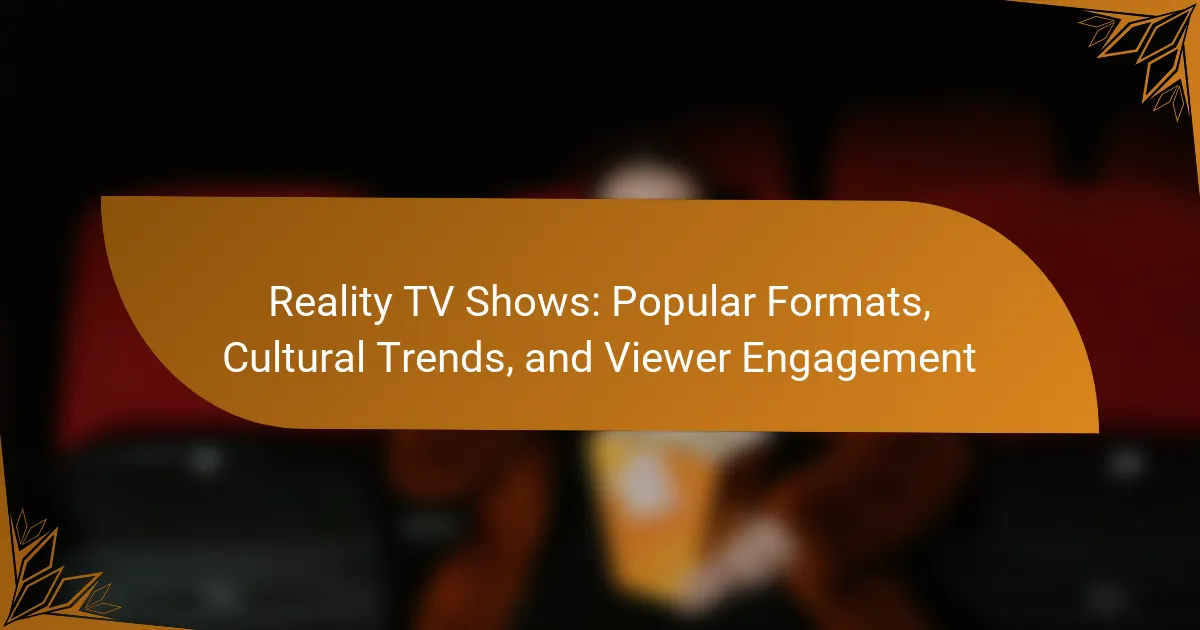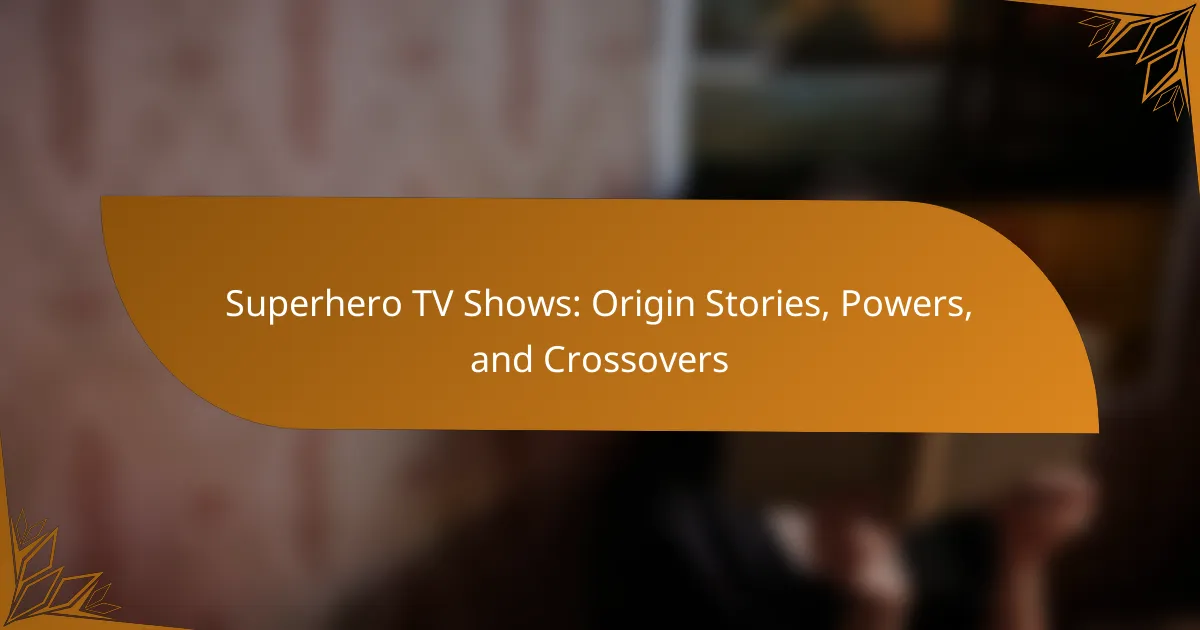Reality TV shows are unscripted television programs that capture real-life situations, featuring both ordinary people and celebrities. This genre encompasses various formats, including competition-based shows like “Survivor,” documentary-style programs such as “Keeping Up with the Kardashians,” and makeover series like “Queer Eye.” The article explores the popularity of reality TV, which has significantly influenced television programming since the early 2000s, accounting for over 20% of TV viewership as of 2020. It also examines cultural trends associated with reality TV, including social media engagement, the normalization of celebrity culture, and the blending of scripted and unscripted content, all of which contribute to shaping contemporary societal conversations.

What are Reality TV Shows?
Reality TV shows are unscripted television programs that document real-life situations. They often feature ordinary people or celebrities in various scenarios. These shows can include competitions, dating, lifestyle, and documentary-style formats. Popular examples include “Survivor,” “The Bachelor,” and “Keeping Up with the Kardashians.” Reality TV gained prominence in the early 2000s, significantly influencing television programming. According to a 2020 Nielsen report, reality shows accounted for over 20% of total TV viewership. This genre appeals to audiences due to its relatable content and unscripted drama.
How did Reality TV Shows originate?
Reality TV shows originated in the early 1990s. They emerged as a new television genre focusing on unscripted content. The first notable example was “The Real World,” which premiered on MTV in 1992. This show featured real people living together and facing various social dynamics. Its success paved the way for numerous similar programs. Reality TV gained popularity due to its relatable content and voyeuristic appeal. By the late 1990s and early 2000s, shows like “Survivor” and “Big Brother” further established the genre. These programs attracted large audiences and became cultural phenomena.
What historical events contributed to the rise of Reality TV?
The rise of Reality TV was significantly influenced by several historical events. The introduction of “The Real World” on MTV in 1992 marked a pivotal moment. This show showcased real people living together, setting a precedent for the genre. The success of “Survivor” in 2000 further propelled reality television into mainstream culture. It combined competition with unscripted drama, attracting a vast audience. The advent of the internet and social media also played a crucial role. These platforms allowed viewers to engage with shows and contestants in real-time. Additionally, the 2008 writers’ strike in Hollywood led to a surge in unscripted programming. Networks turned to reality shows as a cost-effective alternative during this period. These events collectively shaped the landscape of Reality TV, making it a dominant force in entertainment.
Who were the pioneers of Reality TV programming?
The pioneers of Reality TV programming include producers like Mary-Ellis Bunim and Jonathan Murray. They created “The Real World” in 1992. This show is often credited with launching the modern reality television genre. It focused on real people living together and showcased their interactions. The format broke traditional storytelling methods in television. Other early examples include “Survivor,” created by Mark Burnett in 2000. These shows set the foundation for countless reality formats that followed. Their influence can be seen in today’s diverse reality programming landscape.
What are the defining characteristics of Reality TV Shows?
Reality TV shows are defined by their unscripted nature and focus on real-life situations. They often feature ordinary people rather than professional actors. These shows typically emphasize drama, conflict, and emotional moments. Reality TV often includes competitions or challenges that engage participants and viewers alike. The format frequently incorporates confessionals, where participants share thoughts directly with the audience. Audience interaction is a common element, as viewers may influence outcomes through voting. Genres within reality TV include dating, talent competitions, and lifestyle shows. According to a 2021 Nielsen report, reality TV consistently ranks among the most-watched genres on television, demonstrating its popularity and cultural impact.
How do Reality TV Shows differ from scripted television?
Reality TV shows differ from scripted television primarily in their production and storytelling approach. Reality TV is unscripted and features real people in genuine situations. Scripted television, on the other hand, involves actors portraying characters in pre-written scripts. Reality shows often focus on documenting real-life events, challenges, or competitions. Scripted shows typically follow a narrative arc with developed plots and character progression.
Additionally, reality TV often relies on audience participation and viewer engagement, such as voting or social media interaction. Scripted television usually maintains a more controlled narrative structure without direct audience involvement. The unscripted nature of reality shows can lead to unpredictable outcomes, while scripted series follow a predetermined storyline. This distinction highlights the fundamental differences in how both formats engage viewers and deliver content.
What genres fall under the Reality TV umbrella?
Reality TV encompasses several genres. These include competition shows, docuseries, dating shows, and makeover shows. Competition shows feature contestants vying for a prize, such as “Survivor” and “The Amazing Race.” Docuseries provide a glimpse into real-life situations, exemplified by “Keeping Up with the Kardashians.” Dating shows focus on romantic connections, like “The Bachelor.” Makeover shows transform participants’ appearances or lifestyles, as seen in “Queer Eye.” Each genre has distinct characteristics that contribute to the overall reality TV landscape.

What are the Popular Formats of Reality TV Shows?
Popular formats of reality TV shows include competition-based, documentary-style, and makeover formats. Competition-based shows feature contestants competing for a prize. Examples include “Survivor” and “The Amazing Race.” Documentary-style shows focus on real-life events and personal stories. “Keeping Up with the Kardashians” exemplifies this format. Makeover formats showcase transformations, often in lifestyle or appearance. “Queer Eye” is a notable example. Other formats include dating shows, such as “The Bachelor,” and social experiments like “Big Brother.” Each format engages viewers with unique storytelling and character dynamics.
What are the most common formats in Reality TV?
The most common formats in Reality TV include competition, documentary, and makeover. Competition formats often feature contestants vying for a prize, such as “Survivor” or “The Amazing Race.” Documentary formats showcase real-life situations, often following individuals or families, like “Keeping Up with the Kardashians.” Makeover shows focus on transforming individuals or spaces, exemplified by “Queer Eye” and “Extreme Makeover: Home Edition.” These formats engage viewers through relatable content and dramatic storytelling.
How do competition-based formats engage viewers?
Competition-based formats engage viewers by creating suspense and emotional investment. These formats often involve high-stakes challenges that captivate audiences. Viewers become emotionally attached to contestants, rooting for their favorites. This emotional connection drives engagement and encourages audience participation. For instance, shows like “Survivor” have demonstrated that viewers are more likely to tune in when they feel invested in the contestants’ journeys. Additionally, competition-based formats often incorporate elements of unpredictability. This unpredictability keeps viewers on the edge of their seats, enhancing their overall viewing experience. Research indicates that competitive reality shows consistently attract larger audiences due to these engaging elements.
What makes docuseries a popular choice in Reality TV?
Docuseries are popular in reality TV due to their engaging storytelling and real-life subject matter. They provide viewers with an immersive experience, often exploring complex themes. This format allows for in-depth character development and emotional connections. According to a 2021 study by the Pew Research Center, 73% of viewers appreciate the authenticity that docuseries offer. The blend of entertainment and information keeps audiences invested. Additionally, docuseries often tackle social issues, resonating with viewers on a personal level. Their popularity is further fueled by platforms like Netflix, which have increased access to diverse docuseries.
How do different formats affect viewer perception?
Different formats significantly influence viewer perception in reality TV shows. Formats like competition, documentary, and scripted elements shape how audiences interpret the content. For instance, competition formats often create a sense of urgency and excitement. Viewers may become more engaged due to the stakes involved. Documentary-style formats can foster a sense of authenticity and connection with participants. This format encourages viewers to empathize with the individuals portrayed. Scripted elements can lead to skepticism about the authenticity of the events. Viewers might question the reality of the situations presented. A study by the Pew Research Center found that 45% of viewers prefer unscripted formats for their perceived honesty. This data illustrates how format choices directly impact audience engagement and perception.
What role does audience participation play in Reality TV formats?
Audience participation is crucial in Reality TV formats. It enhances viewer engagement and creates a sense of community. Audiences often influence the show’s direction through voting or social media interactions. This involvement can determine outcomes, such as eliminations or winners in competition-based formats. Research shows that shows like “American Idol” have significantly higher ratings due to audience voting. This participation fosters emotional investment in the contestants and storyline. Ultimately, audience participation transforms passive viewers into active participants, increasing the show’s popularity and longevity.
How do format variations influence storytelling in Reality TV?
Format variations significantly influence storytelling in Reality TV by altering narrative structures and viewer engagement. Different formats, such as competition, documentary, and lifestyle, create unique storytelling approaches. For example, competition shows often emphasize conflict and resolution, driving suspense and viewer investment. In contrast, documentary-style formats focus on character development and real-life situations, fostering emotional connections.
Research indicates that format variations can affect audience perception and emotional responses. A study by Nabi et al. (2006) found that viewers engage more deeply with narratives that align with their expectations of a specific format. Furthermore, the pacing and editing style in these formats can shape the overall narrative arc, impacting how stories are perceived over time.
Overall, the choice of format in Reality TV is crucial for storytelling effectiveness, as it dictates how narratives unfold and resonate with audiences.

What Cultural Trends are Associated with Reality TV Shows?
Reality TV shows are associated with several cultural trends. One prominent trend is the rise of social media engagement. Viewers often discuss episodes in real-time on platforms like Twitter and Instagram. This interaction enhances the viewing experience and creates a community around the shows. Another trend is the normalization of celebrity culture. Contestants often gain fame and influence, impacting public perception of success. Additionally, reality TV reflects societal values and issues. Shows frequently address topics like diversity and interpersonal relationships. These elements resonate with audiences, shaping cultural conversations. Furthermore, the blending of scripted and unscripted content is notable. Many reality shows incorporate dramatic elements typical of traditional storytelling. This trend blurs the lines between reality and entertainment. Overall, reality TV continues to influence and mirror contemporary cultural dynamics.
How has Reality TV influenced popular culture?
Reality TV has significantly influenced popular culture by shaping trends, behaviors, and societal norms. It has introduced new forms of entertainment that prioritize authenticity and relatability. Shows like “Survivor” and “The Real World” have popularized unscripted formats, altering viewer expectations. This genre often reflects and amplifies social issues, such as race, gender, and class dynamics. Reality TV has also spawned catchphrases and fashion trends that permeate everyday life. According to a study by the Pew Research Center, 64% of Americans believe reality TV influences societal perceptions of real-life events. Additionally, it has given rise to a new class of celebrities, impacting traditional media and advertising.
What societal norms have been challenged by Reality TV?
Reality TV has challenged various societal norms, including perceptions of privacy, authenticity, and relationships. Traditional views on privacy have been disrupted as participants share intimate details of their lives. Authenticity is questioned, as scripted elements blur the line between reality and performance. Furthermore, the portrayal of relationships has shifted, with unconventional dynamics often celebrated. These shows have normalized behaviors that were once considered taboo, such as public conflict and emotional vulnerability. Reality TV reflects and influences societal attitudes, pushing boundaries in areas like gender roles and lifestyle choices.
How do Reality TV Shows reflect current social issues?
Reality TV shows reflect current social issues by showcasing real-life situations and diverse perspectives. They often highlight themes such as inequality, mental health, and relationship dynamics. For example, shows like “Survivor” and “The Real World” address social hierarchies and group conflicts. These programs provide a platform for discussions on race, gender, and class. Research indicates that viewers engage with these topics through the lens of entertainment. According to a study by the Pew Research Center, 64% of viewers believe reality TV mirrors societal norms and challenges. This connection can influence public opinion and awareness of pressing issues.
What are the implications of Reality TV on viewer behavior?
Reality TV significantly influences viewer behavior. It often shapes perceptions of reality and social norms. Viewers may develop unrealistic expectations about relationships and lifestyles. Research indicates that frequent exposure can lead to desensitization to conflict and drama. A study by Tamborini et al. (2013) found that reality TV can increase aggressive thoughts and behaviors. Additionally, viewers may engage in social comparison, affecting self-esteem. This genre encourages active participation, as audiences often discuss and share opinions on social media. Reality TV’s impact extends to consumer behavior, influencing purchasing decisions based on featured products.
How do Reality TV Shows shape audience expectations?
Reality TV shows shape audience expectations by presenting dramatized narratives and exaggerated conflicts. These programs often emphasize sensationalism, leading viewers to anticipate similar experiences in real life. For instance, reality shows like “Keeping Up with the Kardashians” set a standard for celebrity lifestyles that many viewers aspire to emulate. Research indicates that consistent exposure to such content can distort perceptions of reality, making extraordinary situations seem commonplace. A study published in the Journal of Broadcasting & Electronic Media found that reality TV influences audience beliefs about social norms and behaviors. Consequently, viewers may develop unrealistic expectations about relationships, success, and personal interactions based on the portrayals they see.
What impact do Reality TV Shows have on lifestyle choices?
Reality TV shows significantly influence lifestyle choices among viewers. They often shape perceptions of social norms and behaviors. For example, shows that focus on fitness can motivate audiences to adopt healthier habits. A study by the American Psychological Association found that reality TV can affect viewers’ attitudes towards body image. Additionally, lifestyle trends showcased in these programs can lead to increased consumerism. Viewers may purchase products endorsed by their favorite reality stars. This shift in consumer behavior illustrates the direct impact of media on lifestyle decisions. Overall, reality TV serves as a catalyst for change in personal habits and social interactions.
How does viewer engagement manifest in Reality TV?
Viewer engagement in Reality TV manifests through active participation, emotional investment, and social interaction. Audiences engage by discussing episodes on social media platforms. They often share opinions and reactions in real-time during broadcasts. Viewers also participate in voting and decision-making processes, especially in competition-based shows. Emotional responses are heightened due to relatable content and dramatic storytelling. Research indicates that 80% of Reality TV viewers feel personally connected to contestants. This connection fosters loyalty and continued viewership. Additionally, fan forums and online communities enhance viewer interaction and engagement. These platforms allow fans to analyze episodes and speculate on future developments.
What strategies do producers use to enhance viewer engagement?
Producers enhance viewer engagement through various strategies. They utilize interactive elements, such as live voting and social media integration. These features allow viewers to influence outcomes in real-time. Additionally, producers create compelling story arcs to maintain interest. Emotional storytelling resonates with audiences, encouraging them to connect with participants. Strategic casting also plays a crucial role. Diverse and relatable characters attract a wider audience. Furthermore, producers often employ cliffhangers to build suspense. This technique keeps viewers eager for the next episode. Data shows that shows with interactive features have higher viewer retention rates. Engaging content is essential for maintaining audience interest in reality TV.
How does social media play a role in Reality TV viewer interaction?
Social media significantly enhances viewer interaction with Reality TV. It provides a platform for real-time engagement during broadcasts. Viewers can comment, share, and react to episodes instantly. This interaction creates a sense of community among fans. Platforms like Twitter and Instagram enable discussions and fan theories. Polls and live voting increase viewer participation in show outcomes. Social media also allows for behind-the-scenes content, deepening viewer connection. According to a Nielsen report, 80% of Reality TV viewers engage with related social media during shows. This data highlights the integral role of social media in shaping viewer experiences.
What are some best practices for engaging with Reality TV content?
To effectively engage with Reality TV content, viewers should actively participate in discussions about the shows. Engaging on social media platforms enhances the viewing experience. Following hashtags related to the show can connect viewers with a larger community. Additionally, sharing opinions and theories can lead to deeper conversations. Watching episodes live fosters a sense of immediacy and connection with other fans. Joining fan groups or forums allows for interaction with like-minded individuals. Participating in polls or voting can influence show outcomes, making viewers feel invested. Lastly, understanding the production aspects can enhance appreciation for the content.
Reality TV shows are unscripted television programs that capture real-life situations, featuring both ordinary people and celebrities in various contexts. This article explores the origins and defining characteristics of reality TV, highlighting its historical evolution and the cultural trends associated with it. Key formats, such as competition-based, documentary-style, and makeover shows, are examined along with their impact on viewer engagement and behavior. Additionally, the article discusses how reality TV reflects societal issues and influences lifestyle choices, emphasizing the role of social media in enhancing viewer interaction.

